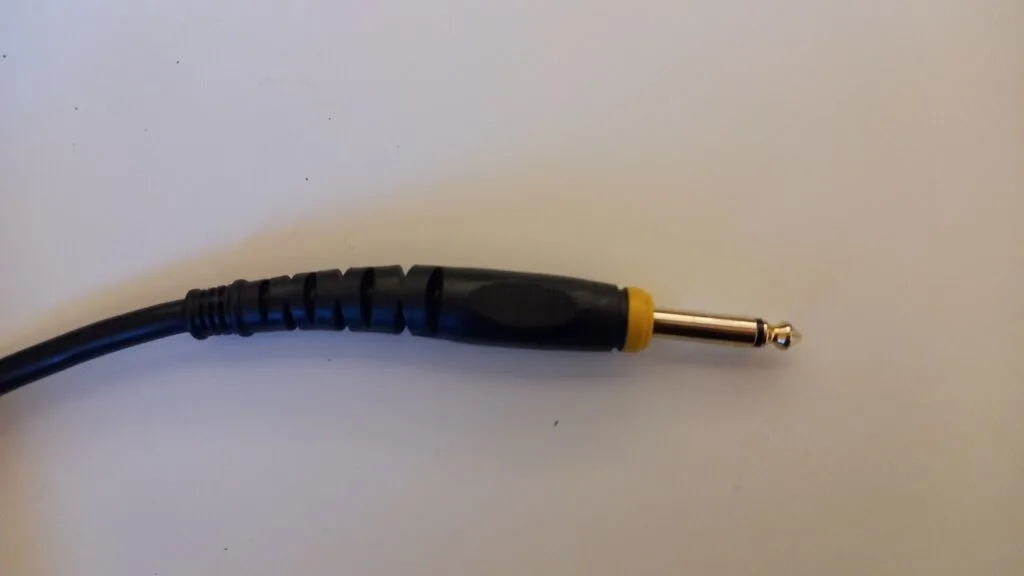If you’re a music producer or audio engineer, you’ve probably come across the terms “balanced” and “unbalanced” cables. If you’re wondering what the differences are between them, then look no further!
It’s a common question that I also had when I first started recording music. Simply put:
A balanced audio cable carries a balanced audio signal which is designed to reduce electrical noise called “interference” introduced during transmission. It can also carry an unbalanced signal. An unbalanced audio cable can only carry an unbalanced audio signal, which is more susceptible to noise.
I’ve explained the differences in much more depth below, including which one you should use and when, and whether one sounds better than the other.
If you take a few minutes to read this article, I’m confident that you’ll leave this page fully understanding the difference between balanced and unbalanced cables.
Understanding Balanced and Unbalanced Audio
To understand which cable is right for you, I’ll first explain what is meant by balanced and unbalanced audio.
What is unbalanced audio?
It’s easiest to explain unbalanced audio first, as it’s the simpler of the 2 types of audio signal.

An unbalanced audio signal is where a single version of an audio signal is sent from one device to another.
This means that the original recorded signal is sent through the cable to a receiving device.
Any nearby electrical equipment will create “electrical interference” that the cable can pick up. This means that unwanted noise (usually a buzz or humming sound) will be added to the signal as it travels through the cable.
When the signal reaches the recording device, it will now include the original signal and the unwanted noise.
The longer the cable is, the more it will pick up noise! Unbalanced cables are best used for short distances only (under 15 feet).
What is balanced audio?
Balanced audio is an audio signal that contains both a positive and negative version of the original signal. These a called polar opposites.

The positive signal is the original sound, and the negative signal is its mirror image.
This is the main difference between balanced and unbalanced audio, and how balanced audio is used to remove any unwanted noise added to the signal as it travels.
Let’s look at an example of a person singing into a microphone using a balanced cable.
When the person sings, the microphone is picking up the audio signal and sending it through the balanced cable to their computer. This cable carries both the positive signal and the negative signal.
As the signal travels from the microphone to the computer, it will pick up noise from electrical equipment. This noise is applied to the positive (original) and negative (mirror) signals equally.
It’s important to know that both noise signals are in the same polarity as each other.
When the audio signal reaches the receiving device, the negative signal is “flipped” to a positive polarity.
This also reverses the polarity of 1 of the noise signals. This makes both noise signals cancel each other out and removes the noise from the signal.
This process is called “Common Mode Rejection”.
Overall, balanced audio improves your signal-to-noise ratio and is commonly found in pro-audio equipment. It’s also essential for audio being sent over distances greater than 15 feet.
Difference between Balanced and Unbalanced Cables
Now that you understand the differences between balanced and unbalanced audio, I can explain the differences between balanced and unbalanced cables and how they work.
What is a balanced cable?
A balanced audio cable is designed with 3 wires: a positive wire, a negative wire, and a shield wire. It can transmit both a balanced and an unbalanced audio signal.
The positive and negative wires carry either the positive or negative audio signals.
The pair of wires are twisted around each other to both reduce any electrical interference. This also ensures that any noise is applied equally to each wire.
The more similar the noise signals are, the easier they are canceled out when one of the polarities is reversed.
The shield wire, as the name suggests, also protects the audio signal from interference. It also protects the cable from interfering from other cables, which is known as “crosstalk”.
Some examples of balanced cables include TRS (Tip, Ring, and Sleeve) and a 3-pin XLR cable.

A balanced cable does not change the audio signal, it just carries both the positive and negative signals. It’s the receiving device that converts the negative signal into a positive signal.
This means that to have a balanced signal, your transmitting device needs to send a balanced signal, and your receiving device needs to be able to receive a balanced signal.
What is an unbalanced cable?
An unbalanced cable consists of 2 wires, a wire to carry the signal and a shield wire.
The signal wire carries the audio signal to the destination, and the shield protects the signal (and carries part of the audio signal).
There’s no reversing of polarities with an unbalanced cable. The signal is delivered as it was input, including any noise picked up along the way.
The shield wire can pick up radio frequency interference at longer distances. For this reason, it’s best to keep unbalanced cables as short as possible (i.e. under 15 feet).
Some examples of unbalanced cables include the RCA and TS (Tip and Sleeve) cables.

In most cases, you can use an unbalanced cable in a balanced output, however, it won’t carry a balanced signal. It will just carry an unbalanced signal.
Having said that, you must never, ever, use an unbalanced cable with a phantom powered microphone. It will damage your equipment and can be potentially dangerous to you. Don’t do it!
Also, if you use an unbalanced cable anywhere in your signal chain, the signal will become unbalanced from that cable onwards.
So, if you want to maintain a balanced signal, make sure you’re using the right cables.
Balanced or unbalanced cables: Which is right for you?
For home studio use, I’ve found that I can use unbalanced cables with no real negative impact to my sound.
My audio is recorded without any additional noise as long as my cables are kept away from power sockets and extension leads.
If you’re looking to play over longer distances, like a larger studio or live venues, then you’ll need to use balanced cables, as you’re more likely to get interference.
If you’re curious, I’ve created a guide beneath as to which cable might be right for you!
Balanced or unbalanced cable for a guitar?
A guitar or bass guitar can only send an unbalanced signal, therefore you will want to use a TS cable.
You can use a TRS cable, but the audio signal will still be unbalanced.
Balanced or unbalanced cable for a microphone?
Microphones mostly send a balanced signal via a balanced XLR cable.
In most cases, especially where phantom power is concerned, you should use a balanced cable.
Again, using an unbalanced cable with phantom power can be extremely dangerous and you should not do it!
If you’re unsure, refer to your user manual or the product manufacturer.
Balanced or unbalanced cable for a synthesizer?
A synthesizer may have either a balanced or unbalanced audio output. This will determine which cable you should use.
I use a TS cable, and can record into my DAW without any noticeable noise.
If you only want to buy one cable, I’d suggest buying a TRS cable as it can transmit both a balanced or unbalanced signal. Refer to your user manual to find out which signal your device can output.
Balanced or unbalanced cable for studio monitors?
Where possible, I recommend using balanced cables for studio monitors. If they’re part of a balanced signal chain, then they will reduce the amount of noise interference. This is important to hearing a clear sound.
You should refer to the user manual to see which kind of audio signal your speaker can receive.
Summary
You’ll now have a better idea of what balanced and unbalanced audio is, how balanced and unbalanced cables work, and which ones are right for you.
For my home studio, I only use unbalanced cables with my instruments. I can’t detect any unwanted noise showing in my DAW’s input. For my microphone, I only use a balanced XLR as it requires phantom power.
That being said, I’ll buy balanced cables for my synthesizers when I move to a larger studio. This is to give myself assurance that the audio signal will be preserved.
To summarize this article:
- Unbalanced audio is more susceptible to noise
- Balanced audio removes interference through a process called “Common Mode Rejection”
- Balanced cables can also be used in unbalanced outputs, but will result in an unbalanced audio signal
- Unbalanced cables can be used in a balanced output, but will still result in an unbalanced audio signal
- Unbalanced cables should be kept as short as possible, and definitely be under 15 feet
Related Questions
Can I use balanced cables with unbalanced equipment?
You can use balanced cables with unbalanced equipment, however, the audio signal will be unbalanced.
Should I use balanced or unbalanced cables?
You can use either balanced or unbalanced cables of your signal is travelling less than 15 feet, as there will be no noticeable difference. For distances longer than 15 feet, you should use a balanced cable as this will reduce the levels of noise as your signal travels longer distances.
Can you make an unbalanced signal balanced?
You can make an unbalanced signal balanced by using a “Direct Box” (DI Box). Any interference picked up by the signal before the DI box, however, will still be present.
Is a balanced signal louder?
At the end of a balanced signal chain, there are 2 identical audio signals in the same polarity. This doubles the amplitude of the original, which increases the signal gain by +6dB.


Conor is a music producer, multi-instrumentalist, and all-round enthusiast from the UK with over 15 years of experience. He’s the founder and sole-content creator for the roundtable audio blog and YouTube channel.
